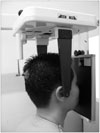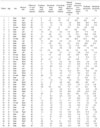Abstract
Purpose
To propose an objective method for evaluating the craniofacial asymmetry in congenital muscular torticollis patients, and to determine the correlation between the craniofacial asymmetry and clinical parameters such as age and the limitation of neck motion.
Materials and Methods
Forty eight patients with congenital muscular torticollis, who underwent cephalometry for an evaluation, were enrolled in this study. The craniofacial curvature on the coronal plane, calvarial asymmetry, and mastoid process length were analyzed on the radiograph of the cephalometry. These radiographic measurements were analyzed to determine the correlation between the craniofacial asymmetry and clinical parameters.
Results
The craniofacial axis was tilted to the affected side by 5.2°±2.8°. The skullbase axis was tilted to the affected side by 2.6°±2.6°, and the mandible axis was tilted to the affected side by 1.0°±2.3°. The difference in the mastoid process length from the skullbase was 7.0%±8.5%. The calvarial width from the vertical midline was 15.4%±11.6% larger in the affected side. In patients older than 5 years, the mandibular tilting angle (p=0.017) and the length of the mastoid process (p=0.007) were greater than those of the younger patients.
Figures and Tables
 | Fig. 1The cephalometry was taken in the posteroanterior projection with the skull stabilized with a device that had references of the external auditory meatus for standardization. |
 | Fig. 2Parameters evaluating the craniofacial asymmetry using cephalometry. (A) The angle between the horizontal meatus line (line connecting bilateral external auditory meatus) and the horizontal petrous line (line connecting the bilateral upper margin of the petrous part of the temporal bone) was defined as the skullbase tilting angle (arrow) and the angle between the horizontal meatus line and the horizontal mandibular line (line connecting bilateral mandibualr angle) was defined as the mandibular tilting angle (arrow head). (B) The angle between the vertical cranial line(line connecting the sagittal suture and the nasal septum) and the vertical facial line(line connecting the nasal septum and the midline of two incisors of the mandible) was defined as the craniofacial tilting angle (arrow). (C) The length of the mastoid process was measured from the upper margin of the petrous part of the temporal bone to the mastoid process tip. The mastoid length difference ratio was calculated; the mastoid length of the normal side was subtracted from that of the involved side and then divided by the length of the normal side. The result is expressed as a percentage parameter. (D) The horizontal length of the skull was measured from a line passing the nasal septum, which is tangential to the horizontal meatus line to the margin of the parietal bone. The difference in the cranial asymmetry length was calculated by subtracting the length of the normal side from that of the involved side and divided by the length of the normal side. The result is expressed as a percentage parameter. (E) The horizontal lengths of the skullbase and mandibular angle were measured from the vertical facial line to the margin of the petrous part of the temporal bone and to the mandibular angle respectively. The skullbase asymmetry and the mandibular asymmetry were calculated by subtracting the length of the involved side from that of normal the side and then divided it by the length of the normal side. The result are expressed as percentage parameters. PB, petrous part of the parietal bone; EAM, External auditory meatus; MA, Mandibular angle; NS, Nasal septum; MI, midline of two central incisor; MP, Mastoid process. |
References
1. Canale ST, Griffin DW, Hubbard CN. Congenital muscular torticollis. A long-term follow up. J Bone Joint Surg Am. 1982. 64:810–816.
2. Cheng JC, Au AW. Infantile torticollis: a review of 624 cases. J Pediatr Orthop. 1994. 14:802–808.
3. Cheng JC, Tang SP. Outcome of surgical treatment of congenital muscular torticollis. Clin Orthop Relat Res. 1999. 362:190–200.

4. Coventry MB, Harris LE. Congenital muscular torticollis in infancy; some observations regarding treatment. J Bone Joint Surg Am. 1959. 41:815–822.
5. Ferguson JW. Cephalometric interpretation and assessment of facial asymmetry secondary to congenital torticollis. The significance of cranial base reference lines. Int J Oral Maxillofac Surg. 1993. 22:7–10.

6. Hollier L, Kim J, Grayson BH, McCarthy JG. Congenital muscular torticollis and the associated craniofacial changes. Plast Reconstr Surg. 2000. 105:827–835.

8. Ippolito E, Tudisco C, Massobrio M. Long-term results of open sternocleidomastoid tenotomy for idiopathic muscular torticollis. J Bone Joint Surg Am. 1985. 67:30–38.

9. Kim HT, Kang JH, Yoo CI. Head tilt and facial asymmetry in congenital muscular torticollis. J Korean Orthop Assoc. 2003. 38:217–222.

10. Landis JR, Koch GG. The measurement of observer agreement for categorical data. Biometrics. 1977. 33:159–174.

11. Ling CM. The influence of age on the results of open sternomastoid tenotomy in muscular torticollis. Clin Orthop Relat Res. 1976. 116:142–148.

12. Ling CM, Low YS. Sternomastoid tumor and muscular torticollis. Clin Orthop Relat Res. 1972. 86:144–150.

13. Malkoc S, Sari Z, Usumez S, Koyuturk AE. The effect of head rotation on cephalometric radiographs. Eur J Orthod. 2005. 27:315–321.

14. Minamitani K, Inoue A, Okuno T. Results of surgical treatment of muscular torticollis for patients greater than 6 years of age. J Pediatr Orthop. 1990. 10:754–759.
15. Shim JS, Noh KC, Park SJ. Treatment of congenital muscular torticollis in patients older than 8 years. J Pediatr Orthop. 2004. 24:683–688.

16. Staheli LT. Muscular torticollis: late results of operative treatment. Surgery. 1971. 69:469–473.




 PDF
PDF ePub
ePub Citation
Citation Print
Print







 XML Download
XML Download